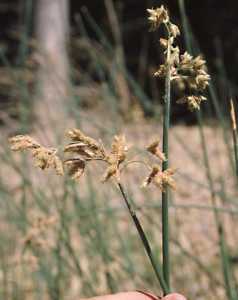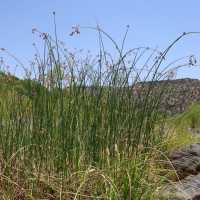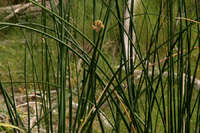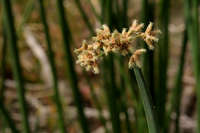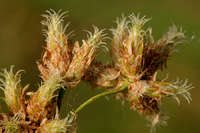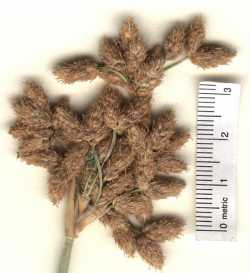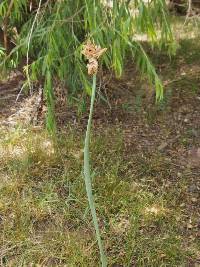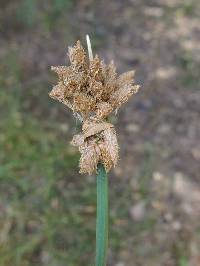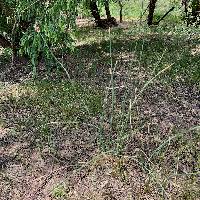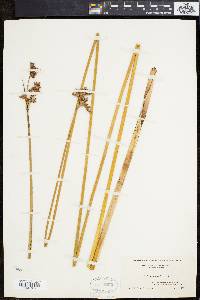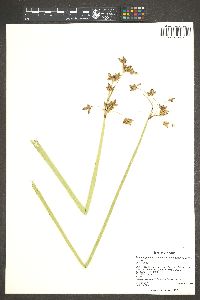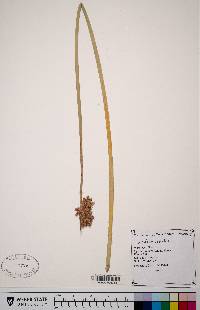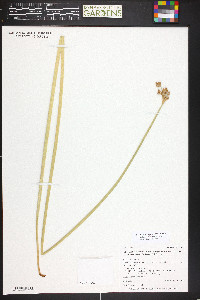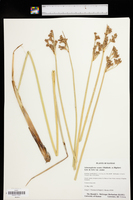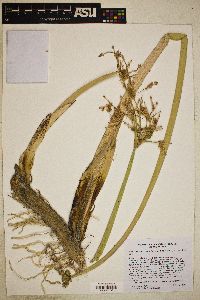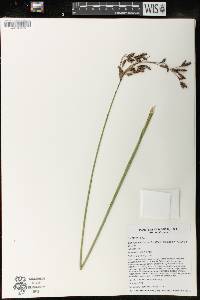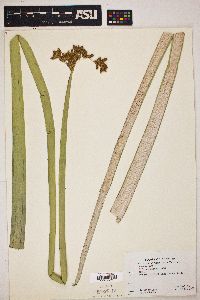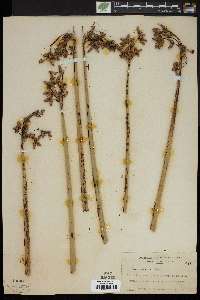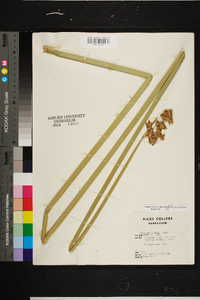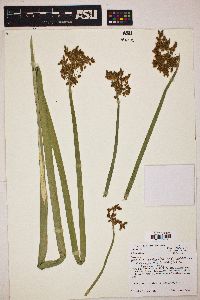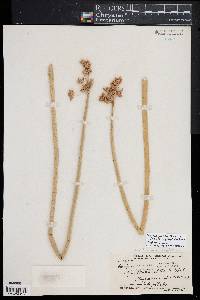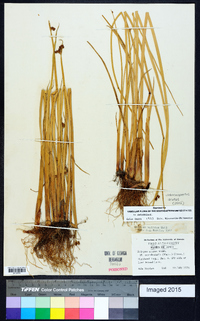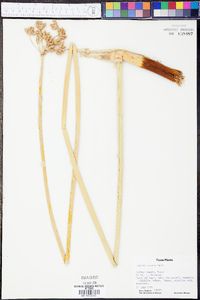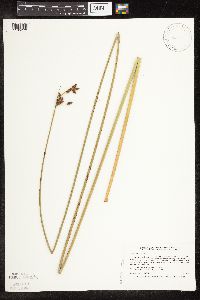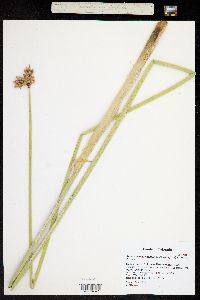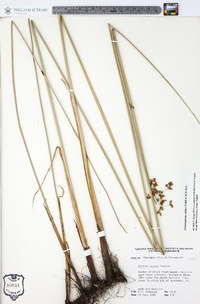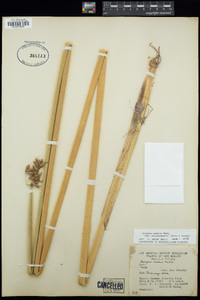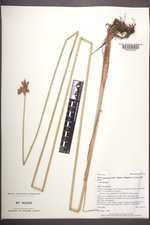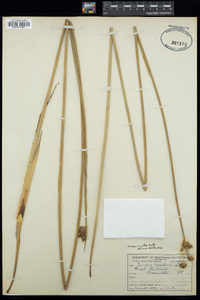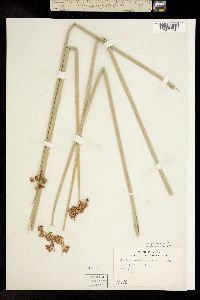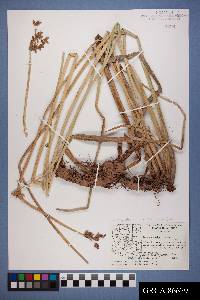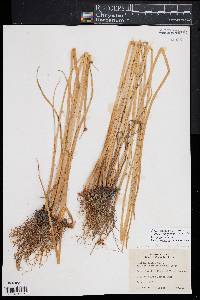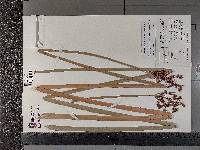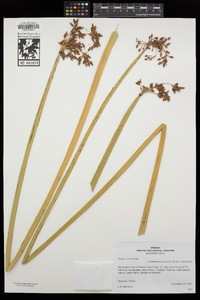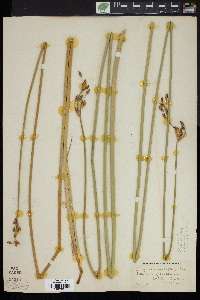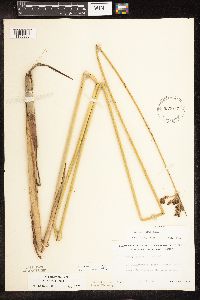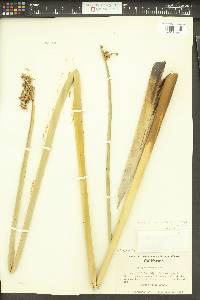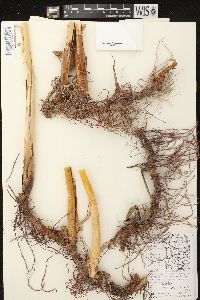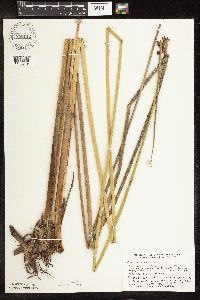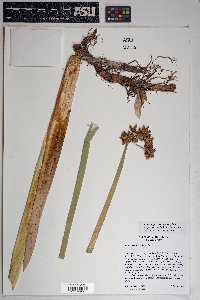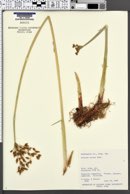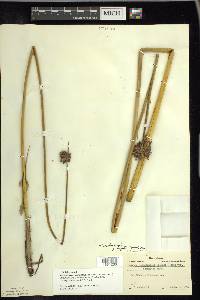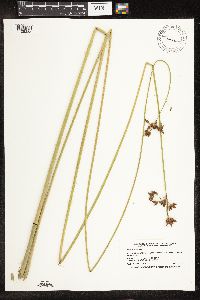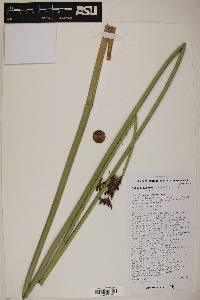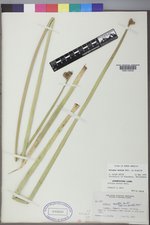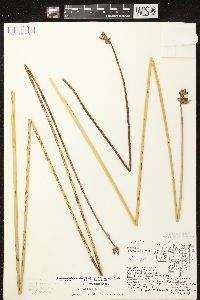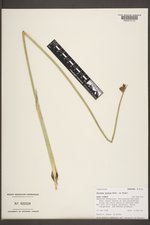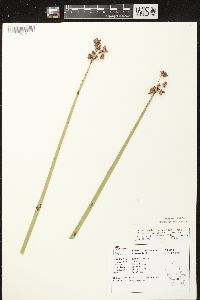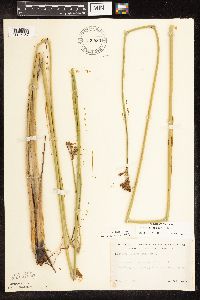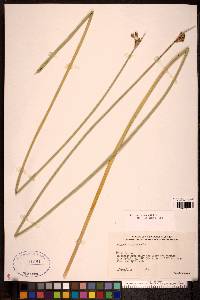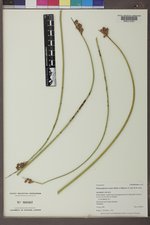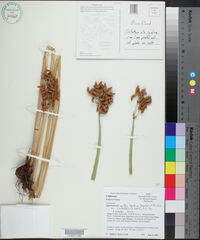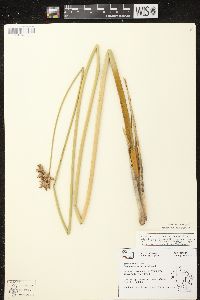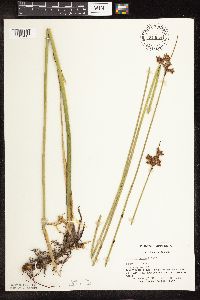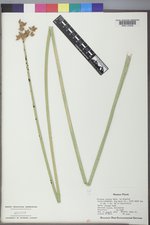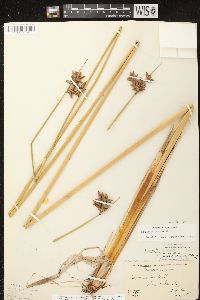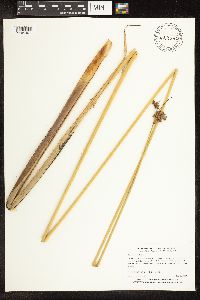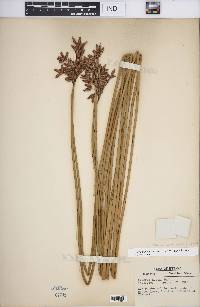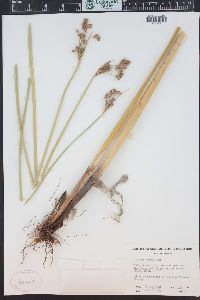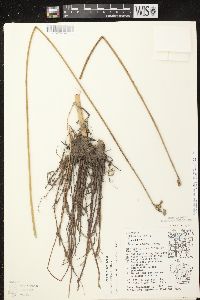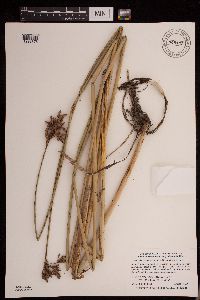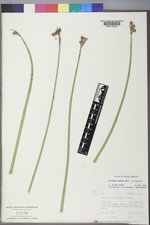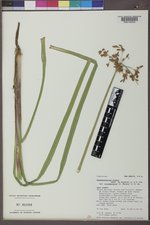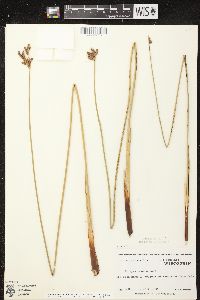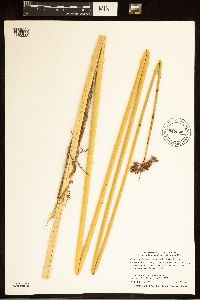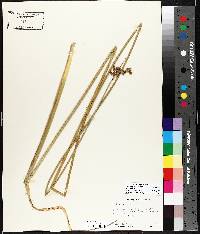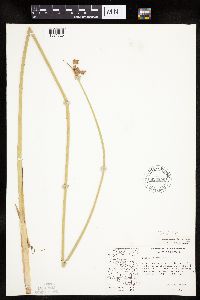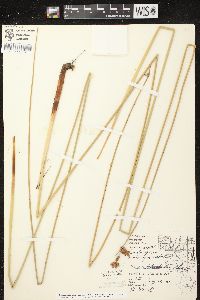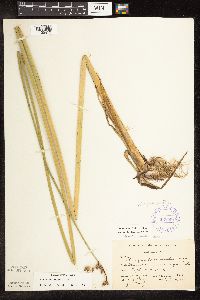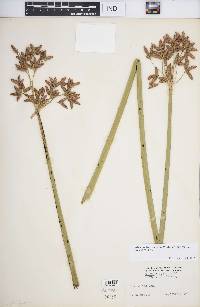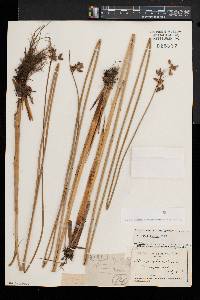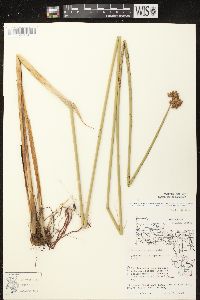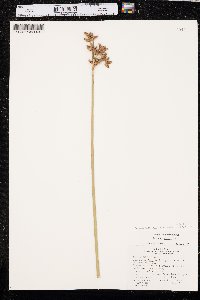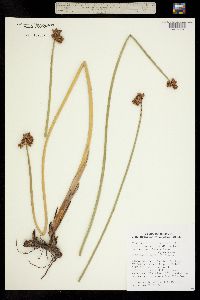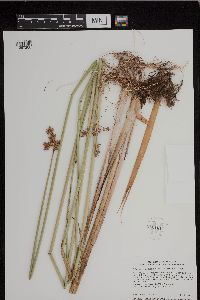
|
|
|
|
Family: Cyperaceae
hardstem bulrush, more...great bulrush, hardstem bulrush, Hard-Stem Wood Club-Rush, Schoenoplectus
[Scirpus acutus Willd. ex Kunth, moreScirpus acutus var. acutus] |
Rhizomes 5-15 mm diam. Culms cylindric, 1-4 m × 2-10 mm. Leaves 3-4, all basal; sheaths often dark reddish proximally, front membranous-translucent and splitting, orifice adaxially deeply V-shaped; blades 1-2, C-shaped to dorsiventrally flat in cross section, usually much shorter than sheath, distal blade 8-120 × 3-7 mm, margins often scabridulous. Inflorescences 2(-3) times branched, open or compact, branches 6(-18) cm; proximal bract usually erect, thickly C-shaped in cross section, 1-9 cm, margins sometimes scabridulous. Spikelets 3-190, solitary or in clusters of 2-8, never all solitary; scales reddish to orange-brown to straw-colored, often variable on same scale, usually wholly or partly straw-colored and prominently lineolate-spotted at 10X, scale or midrib often green when young, ovate, 3-4 × 2-3 mm, sparsely to often densely reddish or straw-colored spinulose-papillose distally or on most of surface, margins ciliate, hairs long, contorted, flanks veinless, apex acute to obtuse, notch 0.3-0.5 mm deep, awn on at least some scales in spikelet usually strongly contorted, 0.5-2 mm (often broken off). Flowers: perianth members (4-)6(-8), brown, bristlelike, equaling achene body or sometimes much shorter, rarely rudimentary, spinulose; anthers 2 mm; styles 2(-3)-fid. Achenes dark gray-brown, plano-convex or rarely weakly trigonous, obovoid, (1.5-)2-3 ´ 1.2-1.7 mm; beak 0.2-0.4 mm. Plants of Schoenoplectus acutus var. occidentalis that have most styles 3-fid, most achenes trigonous, and culms very soft with large air cavities occur at lower elevations in California (mostly southern) and Baja California. In California they often grow on stream bars. They may deserve varietal status. The varieties intergrade throughout most of the west with var. occidentalis. Schoenoplectus acutus hybridizes with Schoenoplectus tabernaemontani, S. heterochaetus, and S. californicus (see also S. tabernaemontani). Although previously assumed to be restricted to North America, some specimens from Eurasia are probably Schoenoplectus acutus, and one very young specimen from Clipperton Island in the eastern Pacific is probably S. acutus var. occidentalis.
Cronquist et al. 1977, Heil et al. 2013 Common Name: hardstem bulrush Duration: Perennial Nativity: Native Lifeform: Graminoid General: Stout perennial rush-like herb, 1-3 m tall, forming large coolonies from rhizomes; stems terete (round in cross section), firm, thick from the middle down to the base. Vegetative: Few leaves, borne toward the base of the stem, with well developed sheath and short, poorly developed blade. Inflorescence: Flowers brownish to grayish, borne in a compact inflorescence at the top of the stem; the inflorescence is subtended by a single conspicuous green bract, which appears to be a continuation of the stem and ends in a pointed tip; the bract is a few cm long, and is almost always shorter than the inflorescence; flowers are small and inconspicuous, each subtended by a brownish scale, 3-4 mm long, and arranged spirally in ovoid structures called spikelets, these 8-15 mm long; spikelets in turn are arranged in small clusters at the tips of ascending or horizonal inflorescence branches; multiple branches emerge from the same point at the top of the stem and form a generally umbellate inflorescence. Achenes are 2 mm long, plano-convex, and hidden behind the slightly larger scale that subtends each flower. Ecology: Found in water and in marshy ground, from 3,500-8,000 ft (1067-2438 m); flowers June-August. Distribution: Found throughout temperate N. Amer., from Quebec to NC, west to AK, BC, WA, OR, and CA Notes: This is a stout, round-stemmed bulrush; look for the clusters of spikelets on inflorescence branches a few centimeters long; and the single erect bract which subtends the inflorescence and looks as though it is a continuation of the stem. Similar to S. validus, but that species has dull orange or reddish brown scales subtending the achenes, and the scales are about the same length as the achenes (S. acutus has gray to brown scales which are noticably longer than the achenes. Ethnobotany: Used to stop bleeding and as a ceremonial emetic; the young shoots and seeds were eaten; and the stems were used as a fiber, to make sandals, clothing,baskets, and bedding. Etymology: Schoenoplectus coms from Greek words schoinos, which means rush, reed, or cord, and plektos, which means twisted or plaited; acutus means acute, or point-tipped. Synonyms: Scirpus acutus Editor: SBuckley 2010, AHazelton 2017 Stout, rhizomatous, colonial perennial 1-3 m; stems terete, stout, firm, not easily crushed between the fingers; lvs few, mainly or all toward the base, commonly with prominent, well developed sheath and short, poorly developed blade (or bladeless); principal bract 2-10 cm, ±erect, like a continuation of the stem; subsidiary bracts small and inconspicuous; spikelets ±numerous in a subumbellately branched infl, all or nearly all sessile in small clusters at the ends of the rather stiff and ascending or horizontal branches of the infl, mostly 8-15 mm, dull gray-brown; scales mostly (3-)3.5-4 mm, thin and largely hyaline- scarious, with numerous short, linear, reddish-brown striolae on a pale, gray-white background, the midrib firm, commonly shortly exserted as a contorted fragile awn ca 1 mm; equaling or a bit longer than the achene; achenes 2.2-2.5 mm, ±completely hidden by the scales, bicarpellate and planoconvex, or occasionally some tricarpellate and unequally trigonous; 2n=38, 40, 42. Marshes and muddy shores of lakes and streams, tolerant of alkali; widespread in temp. N. Amer., and throughout our range. Fr June-Aug. (Schoenoplectus a.) Gleason, Henry A. & Cronquist, Arthur J. 1991. Manual of vascular plants of northeastern United States and adjacent Canada. lxxv + 910 pp. ©The New York Botanical Garden. All rights reserved. Used by permission. |
|
|
|
This project was made possible in part by the Institute of Museum and Library Services [MG-70-19-0057-19].
Powered by Symbiota


